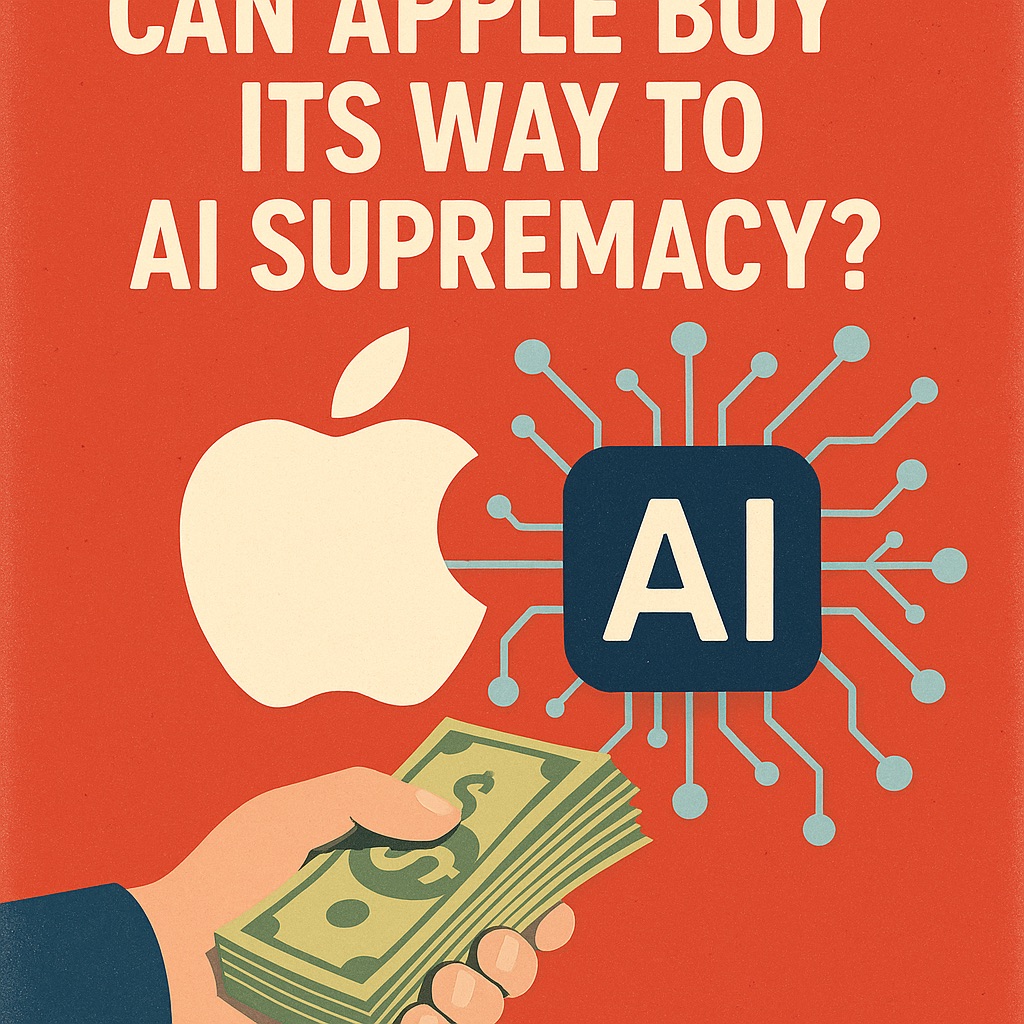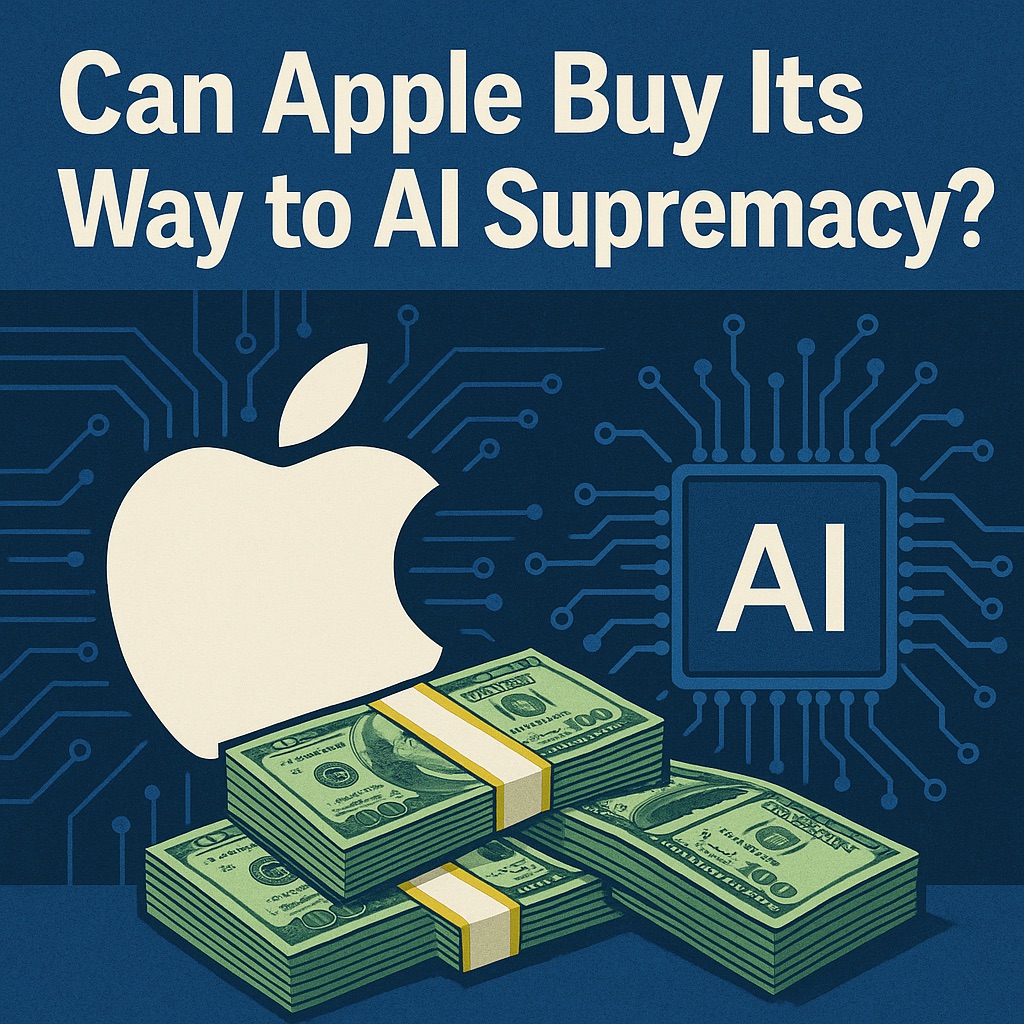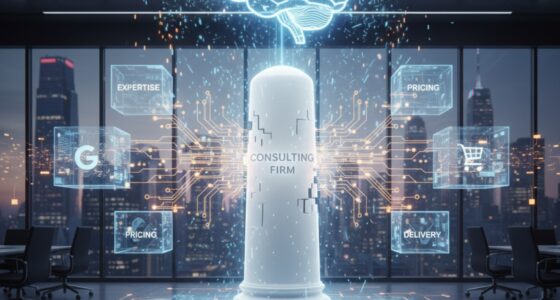While Microsoft and Meta celebrated massive AI-driven earnings beats, Apple faced a different reality. Their quarterly results revealed something shocking: despite record iPhone sales, their AI weakness is becoming a serious problem. But here’s where it gets interesting. Tim Cook just announced Apple is now acquiring companies at an unprecedented rate of one every few weeks. As Cook put it on the earnings call, “We’re open to M&A that accelerates our roadmap.” This represents a dramatic shift from Apple’s traditional strategy of avoiding major acquisitions.
The question is: can throwing money at AI startups actually help Apple catch up in a race they’re already losing? We’ll unpack the earnings gap, examine the M&A spree, and ask if buying talent can close Apple’s AI deficit. What happened during earnings week tells us everything about why Apple made this strategic pivot.

The Earnings Reality Check
Picture this: earnings week arrives, and Microsoft’s earnings soared on a cloud business fueled by AI demand. Meta followed with a stunning performance, crediting AI-driven ad targeting for a hefty revenue bump. Then Apple reports solid iPhone sales and steady services growth, yet their stock barely moves. What’s happening here? Wall Street is sending a clear message about what matters now, and it’s not traditional hardware excellence.

The numbers tell a fascinating story about two completely different approaches to the future. Microsoft’s Azure cloud platform brought in massive quarterly revenue, with CEO Satya Nadella emphasizing how AI workloads are driving unprecedented demand from enterprise customers. These aren’t just incremental improvements we’re talking about. Companies are fundamentally changing how they operate because of Microsoft’s AI tools, and they’re willing to pay premium prices for access. Meta’s situation is equally impressive, with their AI-powered ad targeting generating billions in additional revenue as businesses see measurably better returns on their advertising spend.
Meanwhile, Apple’s earnings call painted a different picture entirely. Yes, they sold plenty of iPhones and their services revenue continued growing, but investors rewarded AI bets more than hardware beats. Here’s why this matters: Apple’s revenue growth of around 6% year-over-year looks respectable in isolation, but it pales compared to the explosive AI-driven expansion their competitors are experiencing. This performance gap becomes even more striking when you consider Tim Cook’s own acknowledgment that AI is “one of the most profound technologies of our lifetime.” The market is essentially saying that steady, predictable growth isn’t enough anymore when your rivals are reshaping entire industries through artificial intelligence.
What does this mean for a company that’s built its reputation on premium hardware and ecosystem lock-in? Wall Street’s reaction reveals something profound about how value creation has shifted in the tech world. Investors used to get excited about iPhone unit sales and services attachment rates. Now they’re laser-focused on AI capabilities, infrastructure investments, and positioning for the next wave of computing.
The analyst commentary following these earnings calls was particularly telling. While Microsoft and Meta analysts focused on AI adoption curves and future revenue potential, Apple analysts spent considerable time discussing innovation concerns and the company’s apparent lack of AI momentum. Several prominent Wall Street firms noted that Apple Intelligence, the company’s flagship AI offering, has failed to generate the kind of excitement or practical utility that competitors are delivering. This isn’t just about missing a quarterly target—it’s about missing an entire technological shift.
Here’s where things get really interesting. Apple sits on nearly $200 billion in cash and investments, more than enough to acquire almost any AI company they want. Yet their earnings performance suggests that money alone might not solve what appears to be a fundamental strategic challenge. The question investors are asking isn’t whether Apple can afford to compete in AI, but whether they understand how to compete in AI. Their cash reserves are impressive, but they haven’t translated into the kind of AI breakthroughs that are driving value for Microsoft and Meta.
This earnings disparity created an unusual situation for Tim Cook. In the subsequent weeks, he made several public statements about Apple being more open to acquisitions than ever before—something that would have been unthinkable during the Steve Jobs era or even earlier in Cook’s tenure. Apple has historically preferred to build rather than buy, maintaining tight control over their technology stack and user experience. But the AI revolution is moving too fast for their traditional approach to keep pace.
What we’re witnessing is essentially a collision between two philosophies of technology development. Apple’s measured, perfectionist approach served them well when they could control the pace of innovation. But AI advancement is being driven by companies willing to iterate quickly, release imperfect products, and improve them rapidly based on user feedback. The earnings results suggest that Wall Street believes speed and AI capability matter more than Apple’s traditional strengths, at least for now. This pressure has forced Apple into territory they’ve rarely explored before.
Apple’s Acquisition Revolution
Cook’s response has been swift and decisive. For years Apple only made small, sub-$200 million tech talent buys—now it’s closing seven deals this year at a pace of roughly one every few weeks. This represents a dramatic departure from the company’s traditional approach to innovation and growth.
What does this mean for a company that once prided itself on organic innovation? Apple’s historical acquisition strategy was remarkably conservative, built around the philosophy that they could develop superior technologies internally while maintaining absolute control over every component of the user experience. They famously passed on major acquisition opportunities, preferring instead to perfect technologies before bringing them to market. This approach worked brilliantly when Apple could set the pace of innovation in their chosen markets, but AI development operates on completely different timelines, and Apple’s measured approach is proving inadequate.
Tim Cook has made several public statements about being open to mergers and acquisitions, signaling a fundamental shift in Apple’s corporate culture. This isn’t just about tweaking their strategy—it’s about acknowledging that their traditional methods aren’t sufficient for the AI era. Cook has specifically highlighted the seven acquisitions Apple has made this year, though he admitted that none were “huge in terms of a dollar amount.” This admission reveals both Apple’s new willingness to acquire companies and their continued hesitation to make truly transformative deals.
Here’s why this matters: the AI companies Apple needs to acquire are becoming increasingly expensive and selective about potential buyers. The most promising AI startups have seen their valuations explode as investors recognize the transformative potential of artificial intelligence. Anthropic’s rumored valuation reached $170 billion, making it nearly impossible for Apple to acquire without making one of the largest tech acquisitions in history. Similarly, companies like Mistral and Perplexity have seen their valuations jump from single-digit billions to the mid-teens, pricing them beyond Apple’s traditional comfort zone for acquisitions. These aren’t gradual increases—they’re dramatic jumps that reflect the market’s recognition of AI’s transformative potential.
With top AI startups commanding sky-high prices, can Apple still find a strategic bargain? Time pressure is becoming a critical factor in Apple’s acquisition strategy. Every month of delay makes potential targets more expensive and potentially less available. Other tech giants are also competing for the same AI talent and technologies, creating bidding wars that drive prices even higher. Apple’s traditional approach of carefully evaluating potential acquisitions over extended periods simply doesn’t work when valuations are changing rapidly and competitors are moving aggressively to secure AI capabilities.
Consider the specific challenges Apple faces in identifying acquisition targets. They need companies with AI expertise that can integrate with their privacy-focused approach and device-centric strategy. This isn’t just about buying any AI company—it’s about finding organizations whose technologies and philosophies align with Apple’s broader ecosystem. The problem is that the best AI companies often have business models and technical architectures that conflict with Apple’s traditional approaches. Many successful AI companies rely on extensive data collection and cloud-based processing, which doesn’t naturally fit with Apple’s emphasis on on-device computing and user privacy.
Bloomberg’s Mark Gurman has expressed skepticism about whether Tim Cook will actually follow through on large acquisitions despite his public statements. Gurman points out that Cook has repeatedly claimed Apple is unafraid of big deals, yet the company has never actually completed one of significant size under his leadership. This creates an interesting tension between Apple’s stated openness to major acquisitions and their demonstrated behavior over the past decade.
The fundamental question becomes whether this acquisition-based approach can realistically bridge the gap with competitors who made massive AI investments years ago. Apple’s admission that none of their recent acquisitions were huge in dollar amounts suggests they’re still approaching AI through incremental additions rather than transformative investments. But the AI landscape Apple is entering presents challenges that go far deeper than deal-making strategy alone.
The AI Catch-Up Challenge
Apple had an early AI head start with Siri in 2011—and still trails today’s leaders. Fast forward to today, and Apple Intelligence feels underwhelming compared to what ChatGPT, Google Assistant, and even Microsoft’s Copilot can accomplish. Here’s the brutal reality: Apple had the early advantage and somehow managed to fall behind everyone else. What does this mean for a company trying to buy its way back into relevance?
Apple Intelligence represents their current AI offering, but the performance gap is obvious when you compare it to competitors. While ChatGPT can write code, analyze complex documents, and engage in sophisticated reasoning, Apple’s AI feels limited to basic tasks like organizing photos and suggesting text responses. Microsoft’s GitHub Copilot has already attracted over 20 million users who rely on it for actual work, while OpenAI’s business user base has grown from 3 million to 5 million paying customers. Meanwhile, Apple’s AI features often feel like polished versions of capabilities we’ve seen elsewhere. The question becomes: can acquisitions actually bridge this technical gap, or is Apple trying to solve a fundamental problem with the wrong approach?
Here’s why throwing money at AI companies might not work the way Apple hopes. The specific integration challenge is enormous: acquired AI built for cloud data centers may conflict with Apple’s on-device privacy model. When you acquire an AI company, you’re not just buying their current technology—you’re betting that their approach will integrate seamlessly with your existing systems. But what happens when the acquired company’s AI architecture conflicts with Apple’s privacy-focused, on-device processing strategy? Picture this: you acquire a company that’s built their AI around cloud-based processing and massive data collection. But Apple’s entire philosophy centers on privacy and on-device computing. How do you merge these fundamentally different approaches? The acquired company’s AI might work brilliantly in their original environment, but it could become significantly less effective when forced to operate within Apple’s constraints.
The talent war in AI creates another layer of complexity, and Silicon Valley is full of cautionary tales about brilliant teams that dissolved after acquisitions, leaving the buying company with little more than intellectual property and empty office space. The best AI researchers and engineers often join startups because they want to work on cutting-edge problems without corporate constraints. When Apple acquires these companies, will the top talent stay, or will they leave for the next exciting opportunity? Apple needs the people behind the technology, not just the technology itself. This isn’t just a technical problem—it’s a philosophical mismatch that money alone can’t solve.
Apple’s privacy-first approach creates an interesting paradox in their AI strategy. Modern AI systems typically improve through access to vast amounts of user data, but Apple has built their brand around protecting user privacy. This constraint might actually become an advantage if they can figure out how to train AI models effectively using on-device data and federated learning techniques. But right now, it feels like a limitation that puts them at a disadvantage compared to companies that can leverage cloud-based AI with access to enormous datasets.
The device-centric strategy Apple is pursuing could theoretically work in their favor. Imagine AI that’s perfectly integrated across your iPhone, Mac, iPad, and Apple Watch, understanding your habits and preferences without sending your data to external servers. This vision is compelling, but executing it requires solving technical challenges that their competitors don’t face. Apple needs to make AI work efficiently on mobile processors with limited battery life, while companies like OpenAI can rely on powerful cloud servers.
What’s particularly interesting about Apple’s situation is the trade-off between speed and control. Organic AI development gives them complete control over the technology and ensures it aligns with their values, but it’s slow. Acquisitions could accelerate their timeline, but they risk ending up with a patchwork of different AI systems that don’t work well together. Microsoft and Google have been investing in AI infrastructure for years, building cohesive platforms that support multiple AI applications. Apple is essentially trying to create this foundation through acquisitions while simultaneously developing consumer products.
The competitive landscape features companies with significant head starts and established user bases. Google has been refining their search algorithms and data processing capabilities for decades. Microsoft has integrated AI throughout their productivity suite and cloud services. OpenAI has captured public imagination with ChatGPT and continues pushing the boundaries of what AI can accomplish. Apple’s massive cash reserves give them options, but money can’t buy the years of experience and iterative improvement that define AI leadership. Can Apple’s privacy-first, on-device vision ever match the scale and speed of cloud-based AI giants?
Conclusion
The acquisition strategy reveals both Apple’s strengths and limitations in this new landscape. Apple brings massive cash reserves and unmatched ecosystem integration to the table, advantages that shouldn’t be underestimated. But AI development demands rapid experimentation, massive datasets, and years of infrastructure building—areas where their traditional perfectionist approach falls short.
Remember, the AI leaders built infrastructure years ago—money alone won’t erase that head start. Success requires cultural commitment to iteration and speed that conflicts with Apple’s measured development style. Their innovation magic worked brilliantly for hardware, but AI operates on different timelines entirely.
What do you think? Where should Apple focus its next big AI play? Drop your thoughts in the comments below, and subscribe for more deep dives into AI strategy and tech’s biggest power shifts.









